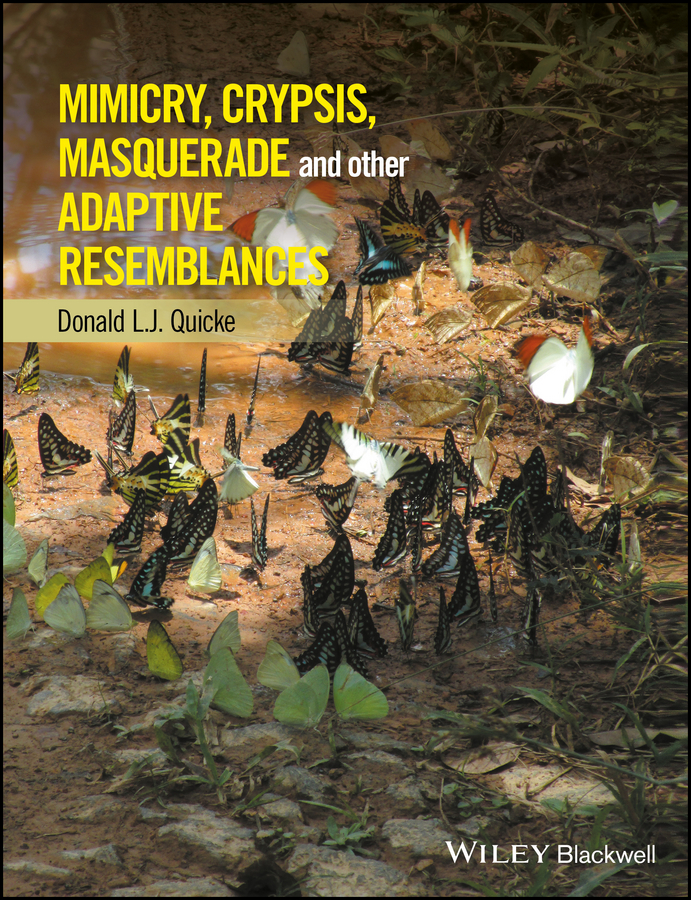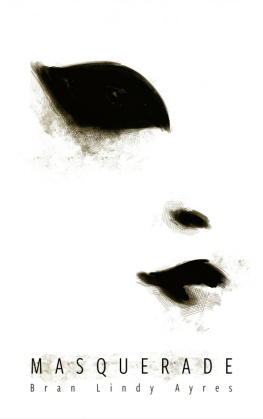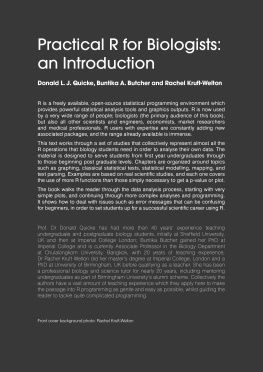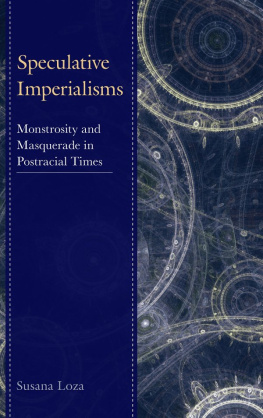Donald L. J. Quicke - Mimicry, Crypsis, Masquerade and Other Adaptive Resemblances
Here you can read online Donald L. J. Quicke - Mimicry, Crypsis, Masquerade and Other Adaptive Resemblances full text of the book (entire story) in english for free. Download pdf and epub, get meaning, cover and reviews about this ebook. year: 2017, genre: Romance novel. Description of the work, (preface) as well as reviews are available. Best literature library LitArk.com created for fans of good reading and offers a wide selection of genres:
Romance novel
Science fiction
Adventure
Detective
Science
History
Home and family
Prose
Art
Politics
Computer
Non-fiction
Religion
Business
Children
Humor
Choose a favorite category and find really read worthwhile books. Enjoy immersion in the world of imagination, feel the emotions of the characters or learn something new for yourself, make an fascinating discovery.

- Book:Mimicry, Crypsis, Masquerade and Other Adaptive Resemblances
- Author:
- Genre:
- Year:2017
- Rating:3 / 5
- Favourites:Add to favourites
- Your mark:
- 60
- 1
- 2
- 3
- 4
- 5
Mimicry, Crypsis, Masquerade and Other Adaptive Resemblances: summary, description and annotation
We offer to read an annotation, description, summary or preface (depends on what the author of the book "Mimicry, Crypsis, Masquerade and Other Adaptive Resemblances" wrote himself). If you haven't found the necessary information about the book — write in the comments, we will try to find it.
Mimicry, Crypsis, Masquerade and Other Adaptive Resemblances — read online for free the complete book (whole text) full work
Below is the text of the book, divided by pages. System saving the place of the last page read, allows you to conveniently read the book "Mimicry, Crypsis, Masquerade and Other Adaptive Resemblances" online for free, without having to search again every time where you left off. Put a bookmark, and you can go to the page where you finished reading at any time.
Font size:
Interval:
Bookmark:

- Chapter 01
- Chapter 02
- Chapter 04
- Chapter 06
- Chapter 07
- Chapter 09
- Chapter 10
- Chapter 11
- Chapter 12
- Chapter 01
- Chapter 02
- Chapter 03
- Chapter 04
- Chapter 05
- Chapter 06
- Chapter 07
- Chapter 08
- Chapter 09
- Chapter 10
- Chapter 11
- Chapter 12
- Chapter 13
- Chapter 14
Donald L. J. Quicke FRES, PhD
Professor, Chulalongkorn University, Bangkok, Thailand

This edition first published 2017 2017 John Wiley & Sons Ltd
All rights reserved. No part of this publication may be reproduced, stored in a retrieval system, or transmitted, in any form or by any means, electronic, mechanical, photocopying, recording or otherwise, except as permitted by law. Advice on how to obtain permission to reuse material from this title is available at http://www.wiley.com/go/permissions.
The right of Donald L. J. Quicke to be identified as the author of this work has been asserted in accordance with law.
Registered Office(s)
John Wiley & Sons, Inc., 111 River Street, Hoboken, NJ 07030, USA
John Wiley & Sons Ltd, The Atrium, Southern Gate, Chichester, West Sussex, P019 8SQ, UK
Editorial Office
9600 Garsington Road, Oxford, OX4 2DQ, UK
For details of our global editorial offices, customer services, and more information about Wiley products visit us at www.wiley.com.
Wiley also publishes its books in a variety of electronic formats and by printondemand. Some content that appears in standard print versions of this book may not be available in other formats.
Limit of Liability/Disclaimer of Warranty
In view of ongoing research, equipment modifications, changes in governmental regulations, and the constant flow of information relating to the use of experimental reagents, equipment, and devices, the reader is urged to review and evaluate the information provided in the package insert or instructions for each chemical, piece of equipment, reagent, or device for, among other things, any changes in the instructions or indication of usage and for added warnings and precautions. While the publisher and authors have used their best efforts in preparing this work, they make no representations or warranties with respect to the accuracy or completeness of the contents of this work and specifically disclaim all warranties, including without limitation any implied warranties of merchantability or fitness for a particular purpose. No warranty may be created or extended by sales representatives, written sales materials or promotional statements for this work. The fact that an organization, website, or product is referred to in this work as a citation and/or potential source of further information does not mean that the publisher and authors endorse the information or services the organization, website, or product may provide or recommendations it may make. This work is sold with the understanding that the publisher is not engaged in rendering professional services. The advice and strategies contained herein may not be suitable for your situation. You should consult with a specialist where appropriate. Further, readers should be aware that websites listed in this work may have changed or disappeared between when this work was written and when it is read. Neither the publisher nor authors shall be liable for any loss of profit or any other commercial damages, including but not limited to special, incidental, consequential, or other damages.
A catalogue record for this book is available from the Library of Congress and the British Library.
ISBN 9781118931530
Cover images: courtesy of Donald L.J. Quicke (except top left on back cover, courtesy of Linda Pitkin)
For all the dogs who live on streets everywhere with noone to love them, and to those wonderful organisations such as Soi Dog Foundation in Thailand, that work hard to care for them.

This is wonderful Puii. She lives at Saphan Taksin Pier.
The ever expanding field of mimicry requires a clear, but very elastic, definition which avoids hair splitting but allows for the constant stream of new examples and concepts.
Miriam Rothschild 1981
This book started almost 40 years ago with discussions with my old friend and fellow undergraduate Peter Kirby at Oxford University and subsequently in Derby and Nottingham, to whom I am greatly indebted for many a valuable discussion and pint of beer. Since then it has expanded due to discussions with many people. As things do, plans got shelved and occasionally revisited, and shelved again. This whole period has seen a remarkable increase in interest in various forms of mimicry and adaptive resemblance with a huge body of more experimental work in addition to theory supplementing the already vast number of casual and sometimes insightful descriptions of mimicry systems around the world.
Ever since Henry Bates (182592), an English naturalist working in tropical South America from 1848 to 1859, realised that some butterflies were not what they might at first appear to be, and interpreted this as being due to palatable species looking like unpalatable models (Bates 1862, 1864), mimetic phenomena have fascinated professional and amateur biologists alike, including Charles Darwin, whose theory of evolution had been part of Bates inspiration (Moon 1976, Stearn 1981). As time passed the literature on the topic grew as more and more examples were described and as Holling (1963) said, A small mountain of information about mimicry has been collected since Bates.
Unfortunately though, after a while this fascination became been tinged with rather negative views among some academic biologists who for some while tended to dismiss it as a quaint set of observations that are easily explained and not worth dwelling over in any great detail though it was still used for its wow factor in undergraduate lectures. VaneWright (1981) also lists some of the negative or simply dismissive views that were put forward, especially soon after Bates publication, including that the resemblances described were just coincidental and therefore pointless to investigate. However, some researchers continued to investigate mimicry both theoretically and experimentally and, with clearer thought emerging about the detailed processes involved, mimicry (and camouflage) have had a resurgence of scientific interest with the result that many new examples have come to light in recent years and many new insights are continuing to emerge. Largescale studies are becoming increasingly common; molecular techniques are allowing the evolution of mimicries and other adaptive resemblances to be viewed from a phylogenetic perspective; and increasingly sophisticated use of computer games allows testing of theories that are relatively new to the scene. LichterMarck et al.s (2014) 4year study of caterpillar predation in a temperate project is a nice example that combines all of these aspects and enabled comparison of the effectiveness of warning and camouflage strategies.
Next pageFont size:
Interval:
Bookmark:
Similar books «Mimicry, Crypsis, Masquerade and Other Adaptive Resemblances»
Look at similar books to Mimicry, Crypsis, Masquerade and Other Adaptive Resemblances. We have selected literature similar in name and meaning in the hope of providing readers with more options to find new, interesting, not yet read works.
Discussion, reviews of the book Mimicry, Crypsis, Masquerade and Other Adaptive Resemblances and just readers' own opinions. Leave your comments, write what you think about the work, its meaning or the main characters. Specify what exactly you liked and what you didn't like, and why you think so.










